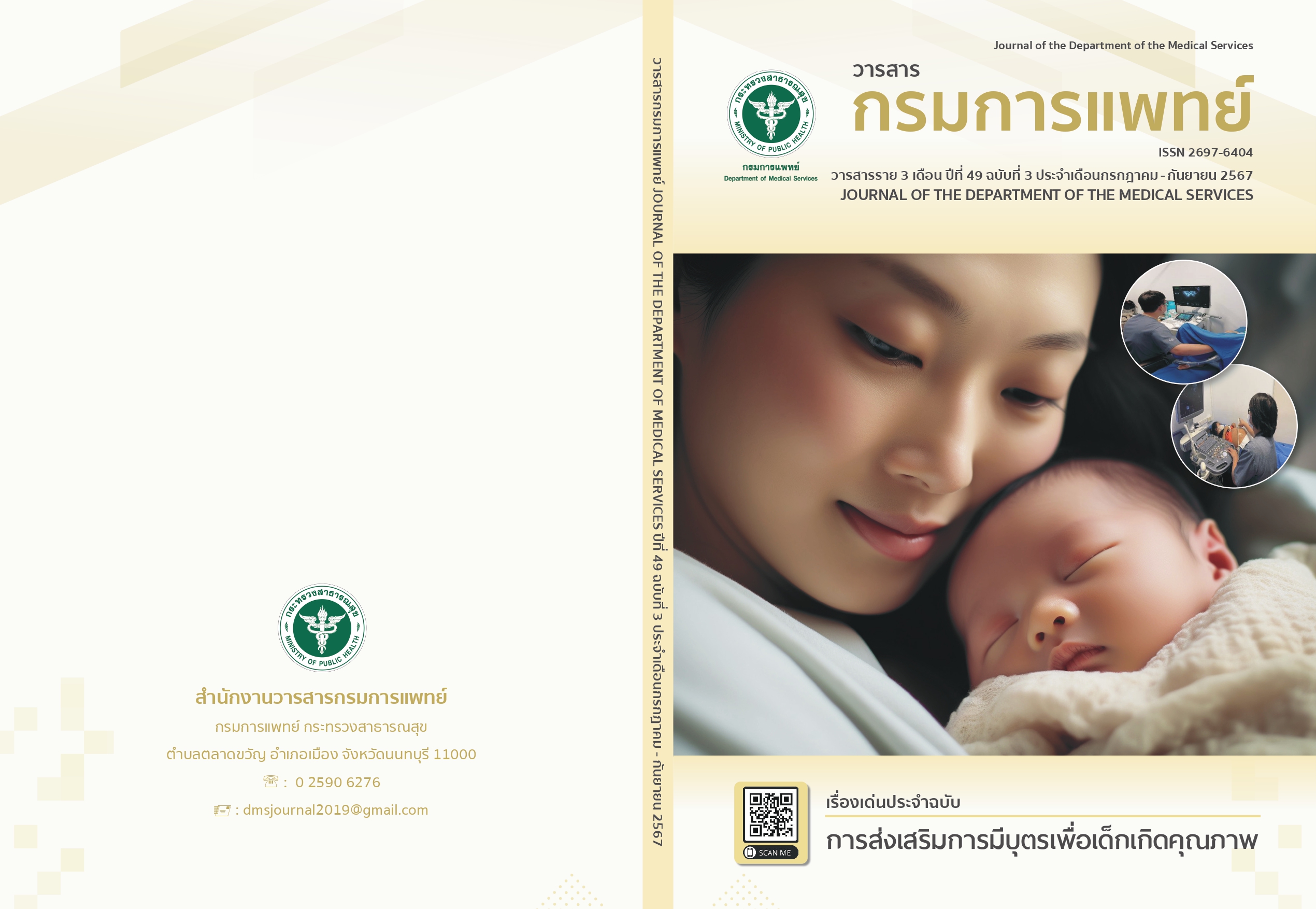Apoptotic Effects of Oryza Sativa L. Extract in Human Melanoma Cell
Keywords:
Malignant melanoma, Oryza sativa L. extract, ApoptosisAbstract
Background: Malignant melanoma, originating from melanocytes, is the most dangerous type of skin cancer. Melanoma treatment includes surgery and the combination of surgery and chemotherapy, immunotherapy, targeted therapy and radiation therapy due to stage of melanoma. Oryza sativa Linn (OS) is a type of black rice found in various regions across Southeast Asia. The main bioactive components of OS extracts are anthocyanins, which have anti-tumor effects. Objective: In this study, we conducted cell viability, the cell cycle, and apoptosis analysis of a human melanoma A375 cells following treatment with OS extract. Methods: The effects of different OS concentrations treatment on human melanoma A375, cell cycle, and apoptosis were assessed by Flow cytometry. The identity of the protein was confirmed through SDS-PAGE and Western blotting. Results: We demonstrated from cell cytotoxicity assay that OS decreases cells viability after OS treatment at concentration 1.25, 2.5, 5 and 10 mg/ml. Flow cytometry showed that OS extract concentration at 2.5 mg/ml induces A375 cell cycle arrest at S phase and 5 and 10 mg/ml OS induces sub-G1 cell cycle arrest. OS extract concentration 2.5, 5 and 10 mg/ml induced A375 cell apoptosis. Apoptosis induction was accompanied by up-regulation caspase-8 and p53 expression. Conclusion: Our data show that the OS disrupted melanoma cell proliferation and induced apoptosis.
References
Lo JA, Fisher DE. The melanoma revolution: from UV carcinogenesis to a new era in therapeutics. Science 2014;346(6212):945-9.
Li C, Yin M, Wang LE, Amos CI, Zhu D, Lee JE, et al. Polymorphisms of nucleotide excision repair genes predict melanoma survival. J Invest Dermatol 2013;133(7):1813-21.
Chapman PB, Hauschild A, Robert C, Haanen JB, Ascierto P, Larkin J, et al. Improved survival with vemurafenib in melanoma with BRAF V600E mutation. N Engl J Med 2011;364(26):2507-16.
Hauschild A, Grob JJ, Demidov LV, Jouary T, Gutzmer R, Millward M, et al. Dabrafenib in BRAF-mutated metastatic melanoma: a multicentre, open-label, phase 3 randomised controlled trial. Lancet 2012;380(9839):358-65.
Guo W, Wang H, Li C. Signal pathways of melanoma and targeted therapy. Signal Transduct Target Ther 2021;6(1):424.
Siegel RL, Miller KD, Fuchs HE, Jemal A. Cancer statistics, 2021. Ca Cancer J Clin 2021;71(1):7-33.
Leenutaphong P, Tancharoen S, Kikuchi K, Nararatwanchai T, Phruksaniyom C, Chaichalotornkul S. Downregulation of tumor promotor genes in oryza sativa linn.-induced antiproliferative activity of human squamous carcinoma cells. Asian Pac J Cancer Prev 2023;24(7):2431-8.
Fan MJ, Wang IC, Hsiao YT, Lin HY, Tang NY, Hung TC, et al. Anthocyanins from black rice (oryza sativa L.) demonstrate antimetastatic properties by reducing MMPs and NF-κB expressions in human oral cancer CAL 27 Cells. Nutr Cancer 2015;67(2):327-38.
Goufo P, Trindade H. Rice antioxidants: phenolic acids, flavonoids, anthocyanins, proanthocyanidins, tocopherols, tocotrienols, γ‐oryzanol, and phytic acid. Food Sci Nutr 2014;2(2):75-104.
Lee JH. Identification and quantification of anthocyanins from the grains of black rice (Oryza sativa L.) varieties. Food Sci Biotechnol 2010;19(2):391-7.
Palungwachira P, Tancharoen S, Phruksaniyom C, Klungsaeng S, Srichan R, Kikuchi K, et al. Antioxidant and anti-inflammatory properties of anthocyanins extracted from Oryza sativa L. in primary dermal fibroblasts. Oxid Med Cell Longev 2019;2019:2089817.
Palungwachira P, Tancharoen S, Dararat P, Nararatwanchai T. Anthocyanins isolated from Oryza Sativa L. protect dermal fibroblasts from hydrogen peroxide-induced cell death. J Nat Sci Biol Med 2020;11(1):45-54.
Tancharoen S, Shakya P, Narkpinit S, Dararat P, Kikuchi K. Anthocyanins extracted from oryza sativa L. prevent fluorouracil-induced nuclear factor-κB activation in oral mucositis: in vitro and in vivo studies. Int J Mol Sci 2018;19(10):2981.
Hengartner MO. Apoptosis: corralling the corpses. Cell. 2001;104(3):325-8.
Poon IKH, Hulett MD, Parish CR. Molecular mechanisms of late apoptotic/necrotic cell clearance. Cell Death Differ 2010;17(3):381-97.
Lin BW, Gong CC, Song HF, Cui YY. Effects of anthocyanins on the prevention and treatment of cancer. Br J Pharmacol 2017;174(11):1226-43.
Diaconeasa Z, Ayvaz H, Ruginǎ D, Leopold L, Stǎnilǎ A, Socaciu C, et al. Melanoma inhibition by anthocyanins is associated with the reduction of oxidative stress biomarkers and changes in mitochondrial membrane potential. Plant Foods Hum Nutr 2017;72(4):404-10.
Rugină D, Hanganu D, Diaconeasa Z, Tăbăran F, Coman C, Leopold L, et al. Antiproliferative and apoptotic potential of cyanidin-based anthocyanins on melanoma cells. Int J Mol Sci. 2017;18(5):949.
Hwang JM, Kuo HC, Lin CT, Kao E-S. Inhibitory effect of liposome-encapsulated anthocyanin on melanogenesis in human melanocytes. Pharm Biol 2013;51(8):941-7.
Chen M, Wang J. Initiator caspases in apoptosis signaling pathways. Apoptosis 2002;7(4):313-9.
Park YH, Han CW, Jeong MS, Jang SB. DED Interaction of FADD and Caspase-8 in the Induction of Apoptotic Cell Death. J Microbiol Biotechnol 2022;32(8):1034-40.
Amaral JD, Xavier JM, Steer CJ, Rodrigues CM. The role of p53 in apoptosis. Discov Med 2010;9(45):145-52.
Jeffers JR, Parganas E, Lee Y, Yang C, Wang J, Brennan J, et al. Puma is an essential mediator of p53-dependent and -independent apoptotic pathways. Cancer Cell 2003;4(4):321-8.
Bennett M, Macdonald K, Chan SW, Luzio JP, Simari R, Weissberg P. Cell surface trafficking of Fas: a rapid mechanism of p53-mediated apoptosis. Science 1998;282(5387):290-3.
Moroni MC, Hickman ES, Lazzerini Denchi E, Caprara G, Colli E, Cecconi F, et al. Apaf-1 is a transcriptional target for E2F and p53. Nat Cell Biol 2001;3(6):552-8.
Downloads
Published
How to Cite
Issue
Section
License
Copyright (c) 2024 Department of Medical Services, Ministry of Public Health

This work is licensed under a Creative Commons Attribution-NonCommercial-NoDerivatives 4.0 International License.
บทความที่ได้รับการตีพิมพ์เป็นลิขสิทธิ์ของกรมการแพทย์ กระทรวงสาธารณสุข
ข้อความและข้อคิดเห็นต่างๆ เป็นของผู้เขียนบทความ ไม่ใช่ความเห็นของกองบรรณาธิการหรือของวารสารกรมการแพทย์



